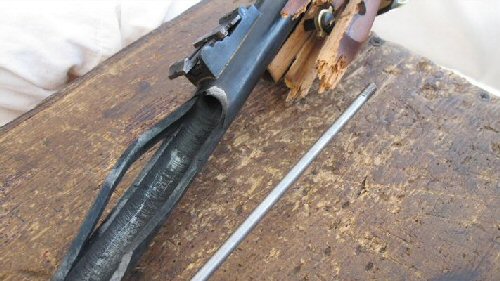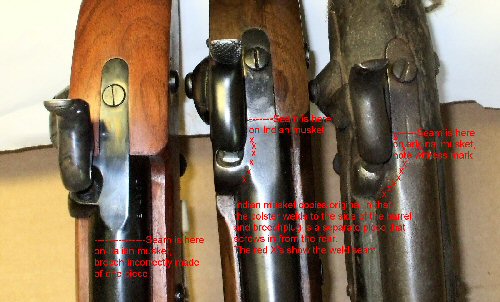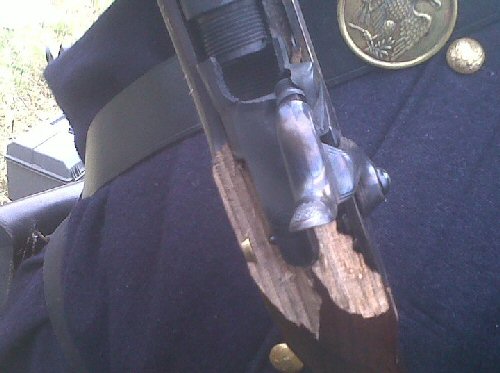|
Here is a link to the lab report from an incident several years ago. An apparently inexperienced reenactor massively overloaded a musket and burst one of our gun barrels. It is estimated that there may have been as many as 9 blank charges in the gun when he touched it off. That would be roughly two ounces of powder which is the same load that would be used as a blank in a 3-pounder cannon. Obviously, an overload of this magnitude would burst the barrel of any musket from any manufacturer from any country. Internet commandos instantly decided that the severely damaged barrel was because it was an "India gun."
The lab report found no flaw in the gun and nothing to indicate that the barrel failed due to any defect or design flaw. In other words, the gun was found to not be defective in any way, and the accident was caused by operator error. The damaged musket was as good and safe as any other smoothbored musket on the market.
Click here to download a PDF of the 4-page lab report from the 2007 musket accident
I've seen lots of guns blown up, everything from an original antique gun that was blown up by some idiot using modern smokeless powder in it to modern machine guns. What they share in common, with very few exceptions, is that the failure was caused by an ammunition problem. When we talk about muzzleloaders, and by muzzleloaders I mean modern made muzzleloading guns as opposed to antiques, there are only two types of accidents that were not ultimately proven to have resulted from operator error. One situation involved a certain model of in-line deer hunting rifle that was sold by CVA (Connecticut Valley Arms) and had a pressed in breechplug instead of a screwed in breechplug. They were recalled because the plugs could blow out right into the shooter's skull. The CVA guns are manufactured in Europe, and several people were maimed or killed by them before they were recalled.
The other, more recent and relevant situation involved an Italian made Enfield replica. The poorly designed breech blew apart. More on that later. Thankfully, the guy wasn't hurt.
In the realm of Civil War guns, there have always been and will always be accidents involving weapons. The problem lies in reenactors who don't seem to grasp that the musket in their hand that "only shoots blanks" is a lethal weapon, and that black powder is dangerous stuff despite only being used to fire blanks. All it takes is one drop of oil in the right spot to keep a caplock from going off. They go through the motions of loading and firing, but since they shut their eyes to pull the trigger, they don't notice that it didn't go off, so they load again...and again...and again...next thing you know, there are 5 or 6 rounds in there, maybe even more.
Then this happens when the drop of oil dries and the gun finally goes off:
Click to enlarge
A Enfield musket from our Canadian competitor that was destroyed by a massive overload in 2011

Anyone who actually knows what they are looking at can tell you that the damaged musket in the photo above was caused by a massive overload. Note the bulged area forward of the sight. There were probably 5 or 6 rounds in it when it went off. Witnesses said it was loud. Of course it was. It takes a LOT of powder to twist and split steel. One blank can't do it, a double load or even a triple load can't do it without a projectile or obstruction in the bore. There are laws of physics that even reenactors have to obey.
This wasn't one of our guns, it was sold by a competitor from Canada. Still, I will defend it, because it is clear to me or anyone else who has studied weapons as long as I have what happened to it. I know who made it, but don't deal with them, because their guns are about two pounds heavier than originals, and they have other authenticity issues.
Here is an original Enfield that was recovered from a battlefield site during the Civil War. It is on display at the Springfield Armory National Historic Site. This original musket burst in exactly the same location as the replica gun shown above, most likely from being fired without the ball properly rammed home. People did stupid things then too.
Click to enlarge
An original 1853 Enfield that was destroyed through user error during the Civil War

Since I'm in teaching mode, below is a comparison of an Italian Armi-Sport Enfield musket, an Indian replica, and an original Enfield to show the construction details. The Armi-Sport does not follow the original, time-proven design and instead relies on castings to assemble the breech of the barrel. We'll come back to the use of a casting for the breech later on. For now, take a look at how the originals were made. The breechplug screws into the rear of the barrel, just like on a flintlock. The bolster is welded to the barrel. On originals, you can generally see a line of discoloration where an apron of metal that is part of the bolster forging was welded to the barrel via forge welding.
On the farby Italian muskets that people are used to, the breech is made of a single part made of some sort of cast metal alloy. The bolster and tang are part of that casting. There is no breechplug. The barrel is threaded and screws into the breech casting, which is a less than ideal situation from an engineering standpoint.
Click to enlarge
A comparison of Italian, Indian and original Enfield barrel construction

Now we keep hearing how the mass-produced Italian muskets are the standard by which others are judged, despite their lack of historical accuracy. For some reason our muskets, that are actually built historically correct, are judged against the Armi-Sports and Euroarms reproductions instead of against actual original muskets. What reenactors SHOULD be doing is comparing their farby Italian guns to originals, but that comes dangerously close to doing actual research. Think about this: if the farby Italian guns are the standard, then if you brought out an original, unissued 1853 Enfield it would not meet the standard. Real Enfields are different from the Italian Enfield copies. The Italian guns have their locks marked with modern style letters, incorrect lock screw washers with round ears, hot tank blued barrels, "black powder only" gibberish on the barrel, and cast metal octagon-to-round breechplugs, none of which matches the real thing.
Earlier I mentioned that cast breech sections are used in the Italian muskets. Take a look at the next photo to see what happens to an Italian gun when the breech lets go. There are no tell-tale signs of an overload as seen in the Indian gun above. This was either the result of a poor design or a bad casting. It is a good example of what happens when you try to recreate a 19th century weapon with 21st century manufacturing methods that are designed to minimize manufacturing cost and maximize profits instead of just copying a design that was perfected 160 years ago.
Click to enlarge
An Armi-Sport Enfield whose breech casting blew apart circa 2010

I have been shooting, building and repairing black powder guns for 28 years, reenacting for 22 years, and selling muzzleloaders professionally for 20 years. These are topics I have studied for decades. When I first got into reenacting, it was the Japanese made muskets the people with Italian guns were bashing. The Japanese guns were mechanically and technically superior to the Italian guns, but let's not let facts get in the way of things. I remember all of the guys trying to impress me by bashing "Jap" guns while carrying their Italian Brown Besses. Their Italian Besses had chrome plated barrels and incorrect "Grice" locks. The Italian locks needed a new mainspring every year or so, because they are made of cast metal instead of forged steel. Now Japanese muzzleloaders are no longer manufactured and the Italians are free to charge whatever they want for their historically inaccurate guns. Reenactors who don't know any better are willing to pay a grand or more for an incorrect gun. It doesn't make sense to me. It's some kind of herd mentality. Sad, really.
Of course, the armchair commandos will tell you that "Japan" stopped selling us muskets because of some massive fluctuation between the Yen and the dollar, but they have no idea what they are talking about. The company that made the old Japanese Besses and Charlevilles did so when companies ordered them. The name of the company was Miroku Heavy Industries and today they are busy making $1500 shotguns and making guns for Browning and other big name gun companies. They couldn't be bothered making a few hundred muskets for American reenactors at this point. Japan didn't sell muskets, a company that happens to be located in Japan did. This commentary about the old Japanese guns is just to try and explain the level of stupidity of the people who are going around trash-talking about "India guns". They don't even grasp that India is a country, not a manufacturing collective. It troubles me to think that people who are that dumb breed and vote without supervision.
When we first introduced Indian made guns to the American 18th century market in 2001 (about 18,000 guns ago), we had to deal with all sorts of ignorant rumors from people who should know better. Reenactors are supposed to be fanatical about research and historic facts, right? Nah, rumors are more fun and make the teller seem like he has some inside knowledge. Eventually that all died down as the guns became more and more well known and the naysayers had to eat their words. Now that we are selling more 19th century style guns and introducing them to a new market, we have to deal with the ignorant rumors all over again from Civil War people despite the excellent track record that these guns have.
One of the things we hear is that "my commanding officer said that Indian guns aren't allowed because they blow up," and that they are supposedly "wallhangers," because they are exported from India without vents. I've got several thoughts on that.
The first one is that the photo above is proof positive that Italian guns "blow up," only with possible actual defects and bad engineering behind them. Why doesn't your CO ban them too? Because he owns one.
Second, I'd be a bit nervous about being led in the field by a CO who isn't smart enough to know the difference between an authentically built musket and a farby one, and is ignorant enough to repeat rumors he heard about Indian guns blowing up without actually knowing what he is talking about.
Third, guns don't just randomly blow up, someone has to load it wrong to blow it up (although the Armi-Sport in the photo above seems like a defective part failure to me despite its awe-inspiring Italian superiority to an Indian made gun).
Fourth, the reason Indian gunmakers export their guns without vents has nothing to do with them being so-called wallhangers; it has to do with restrictive Indian laws. The people who build them are actually not allowed to possess functional guns and yes, a muzzleloader is considered a weapon there, so to build them and export them they need to be in a non-gun state or they go to a nasty Indian prison. I've heard people spout all sorts of wacky theories about why Indian guns are exported without vents, but this is all there is to it. It's not that they are meant to be wall hangers...who would put 100+ man hours of carving, forging and polishing into building a fake gun? It's simply that Indian gun laws suck.
Want to hear some other trivia? The same people that tell you that "India guns" are unsafe will tell you that replica swords and bayonets come with dull edges for safety or liability reasons and to comply with weapons laws. That's just more hot air from people who want to appear smart but really aren't. Replica swords don't come sharpened because, with a dull edge they are classified as "decorative replica handicrafts" or "artistic metal crafts" for tariff purposes. If they came sharpened, they would be considered "swords" legally and subject to a 27% tariff. Nobody wants to pay the extra tariff, so the vast majority of edged weapons are imported unsharpened. Again, it's that simple. People want to see bizarre conspiracies for some reason when the truth is so simple.
If your CO tells you anything to the contrary of what has been stated here and insists it is true when confronted with these statements, he is a moron and you can quote me on that. I'll often get told some nonsense by a new reenactor, and he'll tell me that the nonsense must be correct because his CO said so and his CO has been reenacting a long time. I don't care. If your CO has been reenacting for 30 years, it doesn't give him any special knowledge of how guns work. All it means is that he's been dressing up and making believe he is an officer for a long time. Hell, I've been eating Chinese food for most of my life, but it doesn't mean I know how to make crab rangoon. You have probably been driving a car since you were a teenager, but it doesn't automatically mean you know how to rebuild a transmission.
Fact: Musket barrels made of modern seamless steel, for instance ALL Indian made guns, are dramatically safer than the old original guns with mandrel-wound barrels. In the 17th, 18th and 19th centuries, gun barrels were made by forging a flat bar around a mandrel then forge welding the seam up the bottom. No musket barrels are made that way today. They are all made from seamless steel tubing stock which is turned down to match the desired profile and polished. Brass barrels are turned out of solid round stock but there is a lot of wasted material, one of the reasons brass barrels cost more.
None of this is rocket science, but it is, in fact, a science. As a science, it must be based on facts. The facts are that there has never been an accident with an Indian built musket that has not ultimately been proven to be operator error and that Indian muskets are just as safe as any other muskets. As with any other firearm, they need to be maintained, loaded properly and treated with the respect a deadly weapon demands. As I learned from a BSA firearms instructor when I was 11 years old: the most dangerous part of a gun is the loose nut behind the stock.
|


















